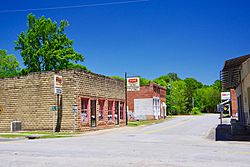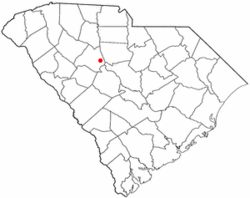Pomaria, South Carolina facts for kids
Quick facts for kids
Pomaria, South Carolina
|
|
|---|---|

Main Street
|
|

Location of Pomaria, South Carolina
|
|
| Country | United States |
| State | South Carolina |
| County | Newberry |
| Area | |
| • Total | 1.05 sq mi (2.73 km2) |
| • Land | 1.05 sq mi (2.71 km2) |
| • Water | 0.01 sq mi (0.02 km2) |
| Elevation | 404 ft (123 m) |
| Population
(2020)
|
|
| • Total | 127 |
| • Density | 121.41/sq mi (46.86/km2) |
| Time zone | UTC-5 (Eastern (EST)) |
| • Summer (DST) | UTC-4 (EDT) |
| ZIP code |
29126
|
| Area code(s) | 803 and 839 |
| FIPS code | 45-57850 |
| GNIS feature ID | 1250208 |
| Website | https://www.townofpomariasc.com/ |
Pomaria is a small town located in Newberry County, South Carolina, in the United States. In 2020, about 127 people lived there.
Contents
History of Pomaria
Early Settlers
Pomaria was first settled in the mid-1700s. The first people to move here were immigrants from Germany, Switzerland, and the Netherlands. They came to America to escape difficult lives and poverty caused by a big war called the Thirty Years' War in Europe.
Many of these early settlers followed the Lutheran religion. They brought their beliefs and ideas with them to Pomaria. The very first meeting of the South Carolina Lutheran Synod (a group of Lutheran churches) was held in the home of John Eichelberger, who lived in Pomaria. Some important leaders of this group also lived or preached in the area.
Hope School and Historic Places
Later, the Hope School became a very important part of Pomaria's history. This school was a Rosenwald School, which were special schools built to help African-American children in rural areas get an education. The land for the school was given by the family of James Haskell Hope. He later became the longest-serving Superintendent of Education for South Carolina.
Besides the Hope School, several other buildings in Pomaria are listed on the National Register of Historic Places. This means they are important historical sites. These include the Folk-Holloway House, the Hatton House, the Pomaria (Summer-Huggins House) (also known as the Summer-Huggins House), and St. John's Lutheran Church.
Famous Resident
Pomaria was also the birthplace and childhood home of Thermon Ruth. He was famous for starting the Selah Jubilee Singers and for helping to promote gospel music at the Apollo Theater in Harlem, New York.
Geography
Pomaria is located at 34°16′0″N 81°25′10″W / 34.26667°N 81.41944°W.
According to the United States Census Bureau, the town covers a total area of about 1.0 square mile (2.7 square kilometers). Almost all of this area is land, with only a tiny bit being water.
Population and People
| Historical population | |||
|---|---|---|---|
| Census | Pop. | %± | |
| 1910 | 238 | — | |
| 1920 | 288 | 21.0% | |
| 1930 | 263 | −8.7% | |
| 1940 | 263 | 0.0% | |
| 1950 | 251 | −4.6% | |
| 1960 | 230 | −8.4% | |
| 1970 | 264 | 14.8% | |
| 1980 | 271 | 2.7% | |
| 1990 | 267 | −1.5% | |
| 2000 | 177 | −33.7% | |
| 2010 | 179 | 1.1% | |
| 2020 | 127 | −29.1% | |
| U.S. Decennial Census | |||
In 2000, there were 177 people living in Pomaria. They lived in 70 households, and 46 of these were families. The town had about 170 people per square mile.
About 54.8 percent of the people were White, and 41.24 percent were African American. A small number of people were from other backgrounds. About 2.26 percent of the population identified as Hispanic or Latino.
In 2000, about 30 percent of the households had children under 18 living with them. The average household had about 2.53 people. The average family had about 2.91 people.
The population was spread out by age. About 23.2 percent were under 18 years old. About 17.5 percent were 65 years or older. The average age in the town was 38 years.
See also
 In Spanish: Pomaria (Carolina del Sur) para niños
In Spanish: Pomaria (Carolina del Sur) para niños

